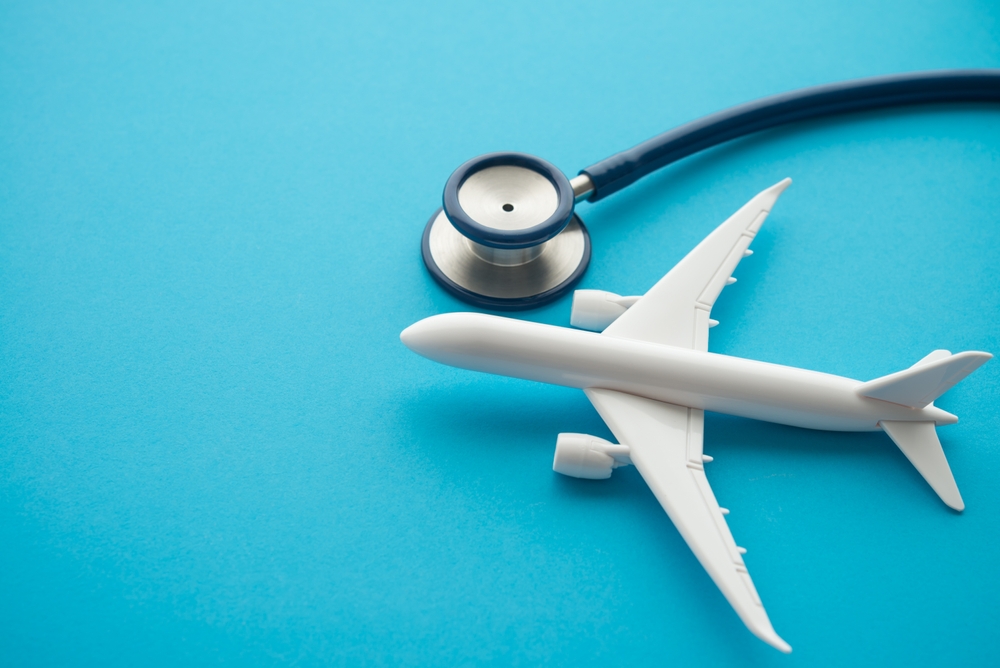This Medscape article caught my eye thanks to its attention grabbing title: ‘Blood Everywhere’: Nurses Control Intense In-Flight Crisis. It’s a well-written account of an in-flight emergency in which the writer, a nurse, saves the day. She describes the frustration of trying to work with limited and weird equipment on the plane. Just reading the article made me decide to include a few other items on my in-flight first aid kit. I have one of those because I have needed it more than once.
I am going to jinx myself by saying that I have not been called upon to do in-flight emergency management in a while. However, for a few years, I was on a roll. It happened so often that I could even predict when the announcement was about to be made, “Is there a doctor on the plane?” It’s always preceded by flight attendants walking fast up and down the aisle and a general commotion that is invariably focused on a middle seat in a packed to capacity plane with an isle so narrow a child could not lie down in it.
One memorable time, I tried to take a medical history in Turkish (bad idea on my part) from a relatively young man who was clearly in pain somewhere in his abdomen (I don’t know enough anatomy words in Turkish to tell you exactly where). He was pale and diaphoretic. The flight attendant told me that the captain wanted me to decide if we should make an emergency landing immediately (somewhere in Europe – not sure where we were), but when this was translated to the patient, he became even more agitated than before and begged to be left alone and land in Germany as planned. Good grief! The captain wanted little old ME to decide if a 747 was going to land somewhere other than its intended destination. Imagine having over 350 people very, very angry with you, and all of them only a few feet away. In a flight to Anchorage, for a man with chest pain, there was no place to land other than Anchorage – and that is a very long flight.
I have spoken to colleagues who have done CPR on planes and provided heroic and lifesaving interventions. I have not saved anyone’s life or ever been heroic. Mostly I have just reassured scared people and family members. But I once wondered if I should intervene to avoid an in-flight emergency. As the COVID-19 pandemic was winding down, I settled into my seat and looked across the aisle at a man who looked like he should be in the emergency department. He looked terrible, had a rapid respiratory rate, was using accessory muscles of respiration and periodically appeared to sort of slump in his chair. The plane hadn’t even taken off so I waved down the attendant to say, “Are you sure that man should be on this flight?” She spoke to him and the came back and reassured me that he said he was fine… I spent the rest of the flight watching him out of the corner of my eye.
I think about in-flight emergencies more these days given the increasing number of wheelchair-bound patients getting preboarded. Americans are generally getting unhealthier by the day, not to mention bigger and thus harder to move on a plane if it was ever necessary to move one of them. And, in case you are wondering, the Turkish man made it to Frankfurt where I handed him over to emergency services personnel. My reward was being the LAST person in the line at passport control, which delayed me more than an hour and nearly caused me to miss my connecting flight. No good deed goes unpunished.
Feel free to share your stories, concerns, and suggestions with me about in-flight medical crises.
–Caroline

Dr. Fife is a world renowned wound care physician dedicated to improving patient outcomes through quality driven care. Please visit my blog at CarolineFifeMD.com and my Youtube channel at https://www.youtube.com/c/carolinefifemd/videos
The opinions, comments, and content expressed or implied in my statements are solely my own and do not necessarily reflect the position or views of Intellicure or any of the boards on which I serve.




I responded once to a plane emergency. A woman had fainted. We were coming in for a landing and she couldn’t clear her ears. I’m an ACHRN. Before I could even attempt to talk to her, I had to produce my license. Precious moments were lost. As I began to help her, a MD announced he was present and a MD. He was not asked to produce a license, he just took over.
Ugh. Just don’t ask if you aren’t going to believe me.
You travel with a copy of your nursing license??
was the “Doctor” on the flight and called to back of the plane to attend to a young man who was obviously intoxicated. Upon returning to my First Class seat I could see that the other passengers were curious. I paused before turning to sit and addressed the cabin with a smile and declared, “Twins”!